1997 GMC SIERRA change wheel
[x] Cancel search: change wheelPage 195 of 436
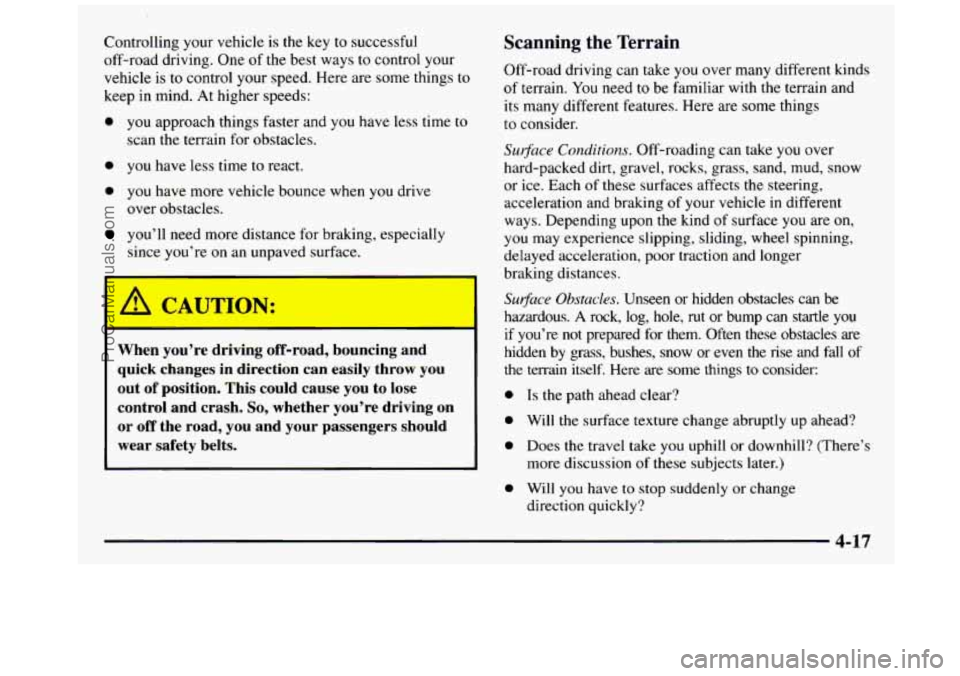
Controlling your vehicle is the key to successful
off-road driving. One of the best ways to control your
vehicle is to control
your speed. Here are some things to
keep in mind.
At higher speeds:
0 you approach things faster and you have less time to
scan the terrain for obstacles.
0 you have less time to react.
0 you have more vehicle bounce when you drive
you’ll need more distance for braking, especially
over
obstacles.
since you’re on an unpaved surface.
When you’re driving off-road, bouncing and
quick changes in direction can
-1 easily throw you
Scanning the Terrain
Off-road driving can take you over many different kinds
of terrain. You need to be familiar with the terrain and
its many different features. Here are some things
to consider.
Su@ace Conditions. Off-roading can take you over
hard-packed dirt, gravel, rocks, grass, sand, mud, snow
or ice. Each of these surfaces affects the steering,
acceleration
and braking of your vehicle in different
ways. Depending upon the kind of surface
you are on,
you may experience slipping, sliding, wheel spinning,
delayed acceleration, poor traction and longer
braking distances.
Surjiuce Obstucles. Unseen or hidden obstacles can be
hazardous.
A rock, log, hole, rut or bump can startle you
if you’re not prepared for them. Often these obstacles are
hidden by grass, bushes, snow or even the rise and fall of
the terrain itself. Here are some things to consider:
out of position. This could cause you to lose
control and crash.
So, whether you’re driving on
or off the road, you and your passengers should
wear safety belts.
0 Does the travel take you uphill or downhill? (There’s
0 Is the path ahead clear?
0 Will the surface texture change abruptly up ahead?
L more discussion of these subjects later.)
0 Will you have to stop suddenly or change
direction quickly?
ProCarManuals.com
Page 197 of 436

Approaching a Hill
When you approach a hill, you need to decide if it’s one of
those hills that’s just too steep
to climb, descend or cross.
Steepness can be hard to judge. On a very small hill, for
example, there may be a smooth, constant incline with only a small change in elevation where
you can easily see all the
way to the top. On
a large hill, the incline may get steeper as
you near
the top, but you may not see this because the crest of
the hill is hidden by bushes, grass or shrubs.
Here are some other things to consider as you approach a hill\
.
0
0
0
0
0
Is there a constant incline, or does the hill get sharply
steeper in places?
Is there good traction on the hillside, or will the
surface cause tire slipping?
Is there a straight path up or down the hill so you
won’t have to make turning maneuvers?
Are there obstructions
on the hill that can block your
path (boulders, trees, logs or ruts)?
What’s beyond the hill?
Is there a cliff, an
embankment, a drop-off, a fence? Get out and walk the
hill if
you don’t know. It’s the smart way to find out.
Is the hill simply too rough? Steep hills often have
ruts, gullies, troughs and exposed rocks because they
are more susceptible
to the effects of erosion.
Driving Uphill
Once you decide you can safely drive up the hill, you
need to take some special steps.
0
0
0
Use a low gear and get a firm grip on the
steering wheel.
Get a smooth start up the hill and try to maintain
your speed. Don’t use more power than you need,
because
you don’t want your wheels to start spinning
or sliding.
Try
to drive straight up the hill if at all possible. If
the path twists and turns, you might want to find
another route.
A CAUTION:
lhrning or driving across steep hills can be
dangerous. You could lose traction, slide
sideways, and possibly roll over.
You could be
seriously injured or killed. When driving up hills,
always try to go straight up.
ProCarManuals.com
Page 203 of 436

Driving in Mud, Sand, Snow or Ice
When you drive in mud, snow or sand, your wheels
won’t get good traction.
You can’t accelerate as quickly,
turning is more difficult, and you’ll need longer
braking distances.
It’s best
to use a low gear when you’re in mud -- the
deeper the mud, the lower the gear.
In really deep mud,
the idea is to keep your vehicle moving
so you don’t
get stuck.
When you drive
on sand, you’ll sense a change in wheel
traction. But it will depend upon how loosely packed the
sand is.
On loosely packed sand (as on beaches or sand
dunes) your tires will tend
to sink into the sand. This has
an effect on steering, accelerating and braking. You may
want to reduce the air pressure in your tires slightly
when driving on sand. This will improve traction.
Hard packed snow and ice offer the worst tire traction.
On these surfaces, it’s very easy to lose control. On wet
ice, for example, the traction is
so poor that you will
have difficulty accelerating. And
if you do get moving,
poor steering and difficult braking can cause you to slide
out of control.
Driving on frozen lakes, ponds or rivers can be
~ dangerous. Underwater springs, currents under
the ice, or sudden thaws can weaken the ice. Your
vehicle could fall through the ice and you and
your passengers could drown. Drive your vehicle
on safe surfaces only.
Driving in Water
Light rain causes no special off-road driving problems.
But heavy rain can mean flash flooding, and flood
waters demand extreme caution.
Find out how deep
the water is before you drive through
it.
If it’s deep enough to cover your wheel hubs, axles or
exhaust pipe, don’t try it
-- you probably won’t get
through. Also, water that deep can damage your axle
and other vehicle parts.
ProCarManuals.com
Page 248 of 436
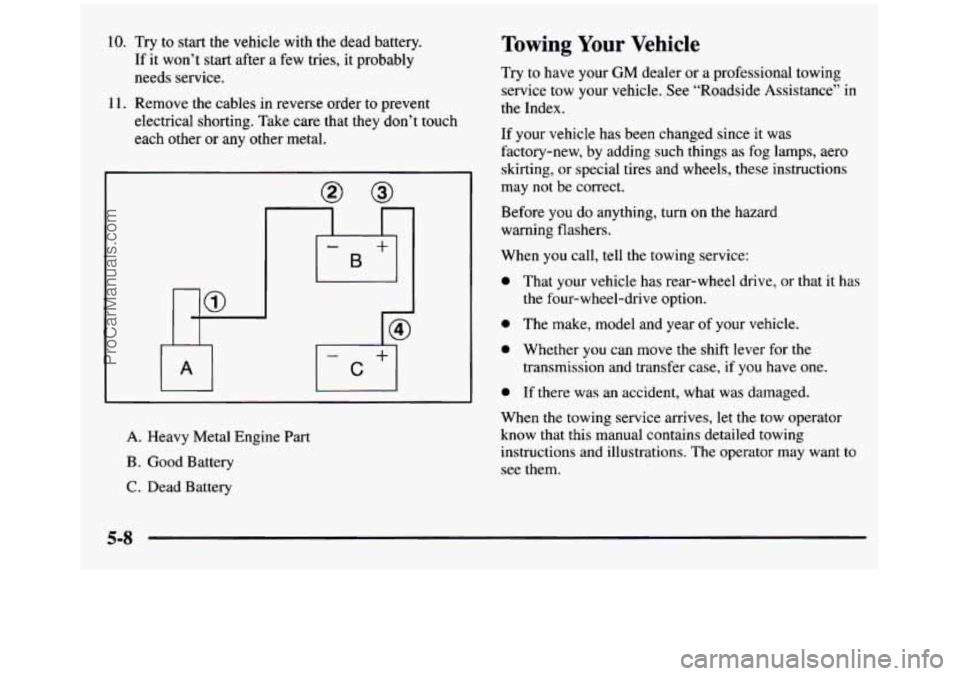
10. Try to start the vehicle with the dead battery.
If it won’t start after a few tries, it probably
needs service.
11. Remove the cables in reverse order to prevent
electrical shorting. Take care that they don’t touch
each other or any other metal.
A. Heavy Metal Engine Part
B. Good Battery
C. Dead Battery
Towing Your Vehicle
Try to have your GM dealer or a professional towing
service tow your vehicle. See “Roadside Assistance”
in
the Index.
If your vehicle has been changed since it was
factory-new, by adding such things as fog lamps, aero
skirting, or special tires and wheels, these instructions
may not be correct.
Before you do anything, turn on the hazard
warning flashers.
When you call, tell the towing service:
0 That your vehicle has rear-wheel drive, or that it has
the four-wheel-drive option.
0 The make, model and year of your vehicle.
0 Whether you can move the shift lever for the
0 If there was an accident, what was damaged.
transmission and transfer
case, if you have one.
When the towing service arrives, let the tow operator
know that this manual contains detailed towing
instructions and illustrations. The operator may want to
see them.
5-8
ProCarManuals.com
Page 261 of 436
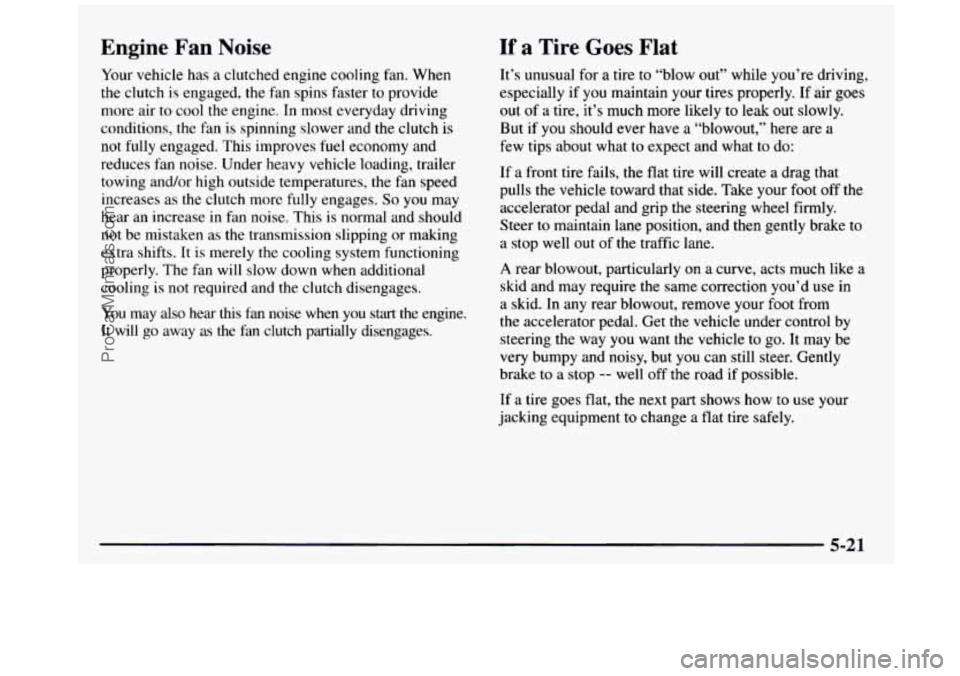
Engine Fan Noise
Your vehicle has a clutched engine cooling fan. When
the clutch is engaged, the fan spi.ns faster to provide
more air
to cool the engine. In most everyday driving
conditions, the fan is spinning slower and the clutch is
not fully engaged. This improves
fuel economy and
reduces fan noise. Under heavy vehicle loading, trailer towing and/or high outside temperatures, the fan speed
increases as the clutch more fully engages.
So you may
hear an increase in fan noise. This
is normal and should
not be mistaken as the transmission slipping or making
extra shifts. It is merely the cooling system functioning
properly. The fan will slow down when additional
cooling is not required and the clutch disengages.
You may also hear this
fan noise when you start the engine.
It will
go away as the fan clutch partially disengages.
If a Tire Goes Flat
It’s unusual for a tire to “blow out” while you’re driving,
especially
if you maintain your tires properly. If air goes
out
of a tire, it’s much more likely to leak out slowly.
But if you should ever have
a “blowout,” here are a
few tips about what to expect and what to do:
If a front tire fails, the flat tire will create a drag that
pulls the vehicle toward that side. Take your foot off the
accelerator pedal and grip the steering wheel firmly.
Steer to maintain lane position, and then gently brake to
a stop well out of the traffic lane.
A rear blowout, particularly on a curve, acts much like a
skid and may require the same correction you’d use in
a skid. In any rear blowout, remove your foot from
the accelerator pedal. Get the vehicle under control by
steering the way you want the vehicle to go. It may be
very bumpy and noisy, but
you can still steer. Gently
brake
to a stop -- well off the road if possible.
If a tire goes flat, the next part shows how to
use your
jacking equipment
to change a flat tire safely.
ProCarManuals.com
Page 262 of 436
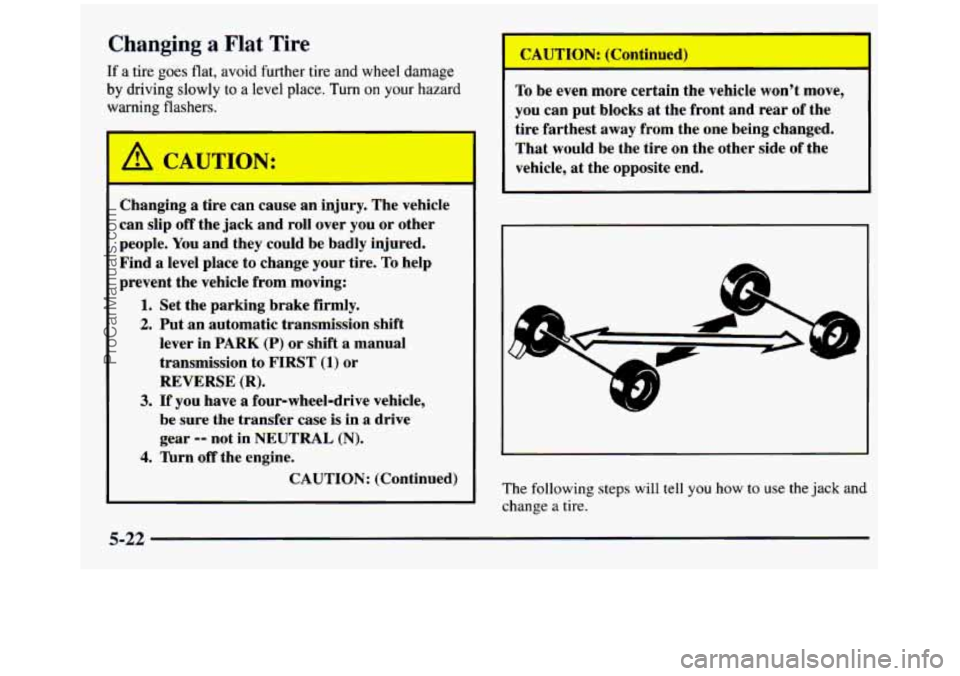
Changing a Flat Tire
If a tire goes flat, avoid further tire and wheel damage
by driving slowly to a level place. Turn on your hazard
warning flashers.
I A CAUTION:
Changing a tire can cause an injury. The vehicle
can slip
off the jack and roll over you or other
people. You and they could be badly injured.
Find a level place
to change your tire. To help
prevent the vehicle from moving:
1. Set the parking brake firmly.
2. Put an automatic transmission shift
lever in
PARK (P) or shift a manual
transmission to
FIRST (1) or
REVERSE (R).
3. If you have a four-wheel-drive vehicle,
be
sure the transfer case is in a drive
gear
-- not in NEUTRAL (N).
4. Turn off the engine.
CAUTION: (Continued)
To be even more certain the vehicle won’t move,
you can put blocks at the front and rear of the
tire farthest away from the one being changed.
That would be the tire on the other side
of the
vehicle, at the opposite end.
The following steps will tell
you how to use the jack and
change
a tire.
5-22
ProCarManuals.com
Page 269 of 436
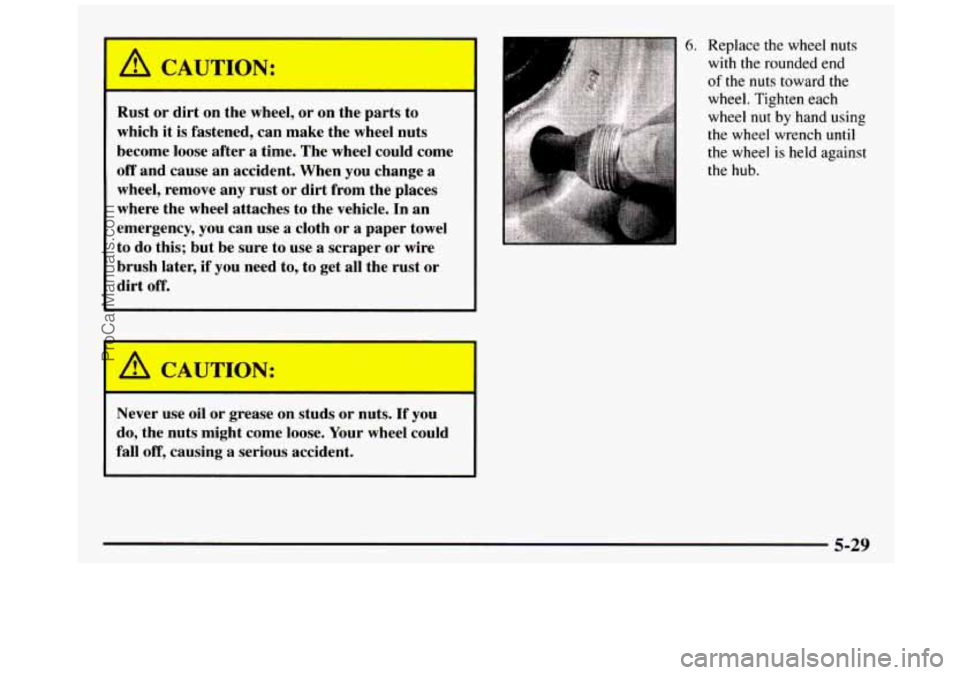
I a CAUTION:
Rust or dirt on the wheel, or on the parts to
which it is fastened, can make the wheel nuts
become loose after
a time. The wheel could come
off and cause an accident. When you change a
wheel, remove any rust or dirt from the places
where the wheel attaches to the vehicle. In an
emergency, you can use a cloth or a paper towel
to do this; but be sure to use a scraper or wire
brush later, if you need to, to get
all the rust or
dirt
off.
b, CAUTION:
Never use oil or grease on studs or nuts. If you
do, the nuts might come loose. Your wheel could
fall
off, causing a serious accident.
6. Replace the wheel nuts
with the rounded end
of the nuts toward the
wheel. Tighten each wheel
nut by hand using
the wheel wrench until
the wheel is held against
the hub.
5-29
ProCarManuals.com
Page 303 of 436
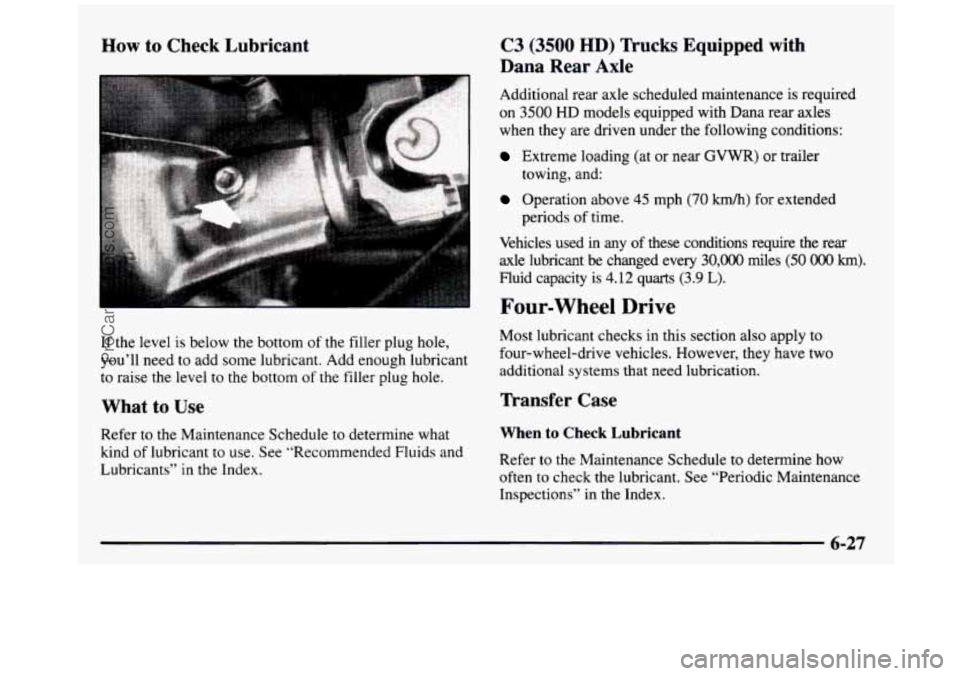
How to Check Lubricant
If the level is below the bottom of the filler plug hole,
you’ll need to add
some lubricant. Add enough lubricant
to raise the level
to the bottom of the filler plug hole.
What to Use
Refer to the Maintenance Schedule to determine what
kind
of lubricant to use. See “Recommended Fluids and
Lubricants”
in the Index.
C3 (3500 HD) Trucks Equipped with
Dana Rear Axle
Additional rear axle scheduled maintenance is required
on
3500 HD models equipped with Dana rear axles
when they are driven under the following conditions:
Extreme loading (at or near GVWR) or trailer
Operation above 45 mph (70 km/h) for extended
towing, and:
periods of time.
Vehicles used in any
of these conditions require the rear
axle lubricant be changed every
30,000 miles (50 OOO km).
Fluid capacity is 4.12 quarts (3.9 L).
Four-wheel Drive
Most lubricant checks in this section also apply to
four-wheel-drive vehicles. However, they have two
additional systems that need lubrication.
Transfer Case
When to Check Lubricant
Refer to the Maintenance Schedule to determine how
often to check the lubricant. See “Periodic Maintenance
Inspections” in the Index.
ProCarManuals.com